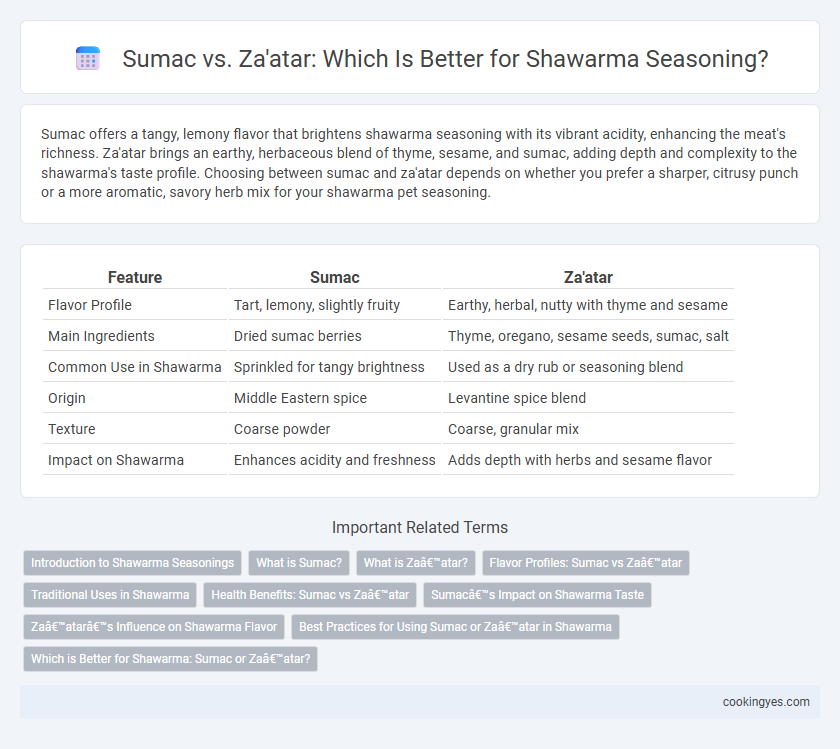Sumac offers a tangy, lemony flavor that brightens shawarma seasoning with its vibrant acidity, enhancing the meat's richness. Za'atar brings an earthy, herbaceous blend of thyme, sesame, and sumac, adding depth and complexity to the shawarma's taste profile. Choosing between sumac and za'atar depends on whether you prefer a sharper, citrusy punch or a more aromatic, savory herb mix for your shawarma pet seasoning.
Table of Comparison
| Feature | Sumac | Za'atar |
|---|---|---|
| Flavor Profile | Tart, lemony, slightly fruity | Earthy, herbal, nutty with thyme and sesame |
| Main Ingredients | Dried sumac berries | Thyme, oregano, sesame seeds, sumac, salt |
| Common Use in Shawarma | Sprinkled for tangy brightness | Used as a dry rub or seasoning blend |
| Origin | Middle Eastern spice | Levantine spice blend |
| Texture | Coarse powder | Coarse, granular mix |
| Impact on Shawarma | Enhances acidity and freshness | Adds depth with herbs and sesame flavor |
Introduction to Shawarma Seasonings
Sumac and za'atar are essential seasonings that enhance the flavor profile of shawarma, a popular Middle Eastern dish known for its aromatic and savory taste. Sumac offers a tangy, lemony zest that brightens the meat, while za'atar combines earthy thyme, sesame seeds, and sumac to deliver a complex, herbaceous depth. Both spices contribute unique layers to shawarma seasoning, balancing acidity and earthiness to create an authentic and flavorful experience.
What is Sumac?
Sumac is a tangy, lemony spice made from dried and ground berries of the sumac plant, commonly used in Middle Eastern cuisine to add a vibrant, slightly acidic flavor to shawarma. Its deep red or burgundy color enriches the visual appeal of dishes while enhancing the overall taste with citrus-like sharpness. Unlike za'atar, which is a blend of herbs and sesame seeds, sumac is a single spice that distinctly brightens the savory, spiced meat in shawarma recipes.
What is Za’atar?
Za'atar is a traditional Middle Eastern spice blend composed primarily of dried thyme, sumac, sesame seeds, and salt, known for its earthy and tangy flavor profile. Unlike pure sumac, which offers a sharp, lemony taste, za'atar provides a complex herbaceous and nutty seasoning ideal for enhancing shawarma's savory layers. Using za'atar in shawarma seasoning brings balanced acidity and aromatic depth, enriching each bite with authentic regional character.
Flavor Profiles: Sumac vs Za’atar
Sumac delivers a tangy, lemony flavor that brightens shawarma with a subtle acidity, enhancing the meat's savory richness. Za'atar combines earthy thyme, nutty sesame seeds, and tangy sumac, offering a complex, herbaceous taste that adds depth and aromatic warmth. Choosing between sumac and za'atar depends on whether a sharp citrus note or a multifaceted herbal blend best complements the shawarma's profile.
Traditional Uses in Shawarma
Sumac is traditionally used in shawarma seasoning for its tangy, lemony flavor that enhances the meat's richness without overpowering it. Za'atar, a blend of thyme, oregano, sumac, and sesame seeds, is less common but adds a herbal, aromatic depth when sprinkled on shawarma or used in marinades. Both spices contribute distinctly to authentic Middle Eastern shawarma, with sumac favored for its sharp acidity and za'atar valued for its complex, earthy notes.
Health Benefits: Sumac vs Za’atar
Sumac is rich in antioxidants and anti-inflammatory compounds that support heart health and digestion, making it a beneficial addition to shawarma seasoning. Za'atar, a blend typically containing thyme, sesame seeds, and sumac, offers immunomodulatory properties and abundant vitamins that boost the immune system and enhance energy levels. Both spices contribute essential nutrients and phytochemicals that promote overall well-being when used to season shawarma.
Sumac’s Impact on Shawarma Taste
Sumac enhances shawarma by imparting a tangy, lemony flavor that brightens the rich, spiced meat, creating a balanced taste profile. Its vibrant acidity cuts through the fat, making each bite more refreshing and less heavy compared to za'atar, which offers an earthy and herbal note. This distinctive sourness from sumac elevates shawarma, highlighting the smoky, savory elements while adding a zesty contrast essential for authentic Middle Eastern flavor.
Za’atar’s Influence on Shawarma Flavor
Za'atar significantly enhances shawarma flavor by infusing it with a unique blend of thyme, sesame seeds, and sumac, creating a well-rounded, earthy, and tangy profile that complements the meat's spices. Its aromatic herbs add depth and freshness, making each bite more vibrant and complex compared to using sumac alone. Za'atar's traditional Levantine roots contribute authenticity, enriching the overall sensory experience of shawarma.
Best Practices for Using Sumac or Za’atar in Shawarma
Sumac enhances shawarma with a vibrant citrusy tang that complements grilled meats by balancing rich flavors and adding depth without overpowering. Za'atar, a blend of thyme, sesame, and sumac, brings an herby, nutty aroma that infuses shawarma with complexity and a subtle earthy warmth. For optimal results, sprinkle sumac before grilling to allow its acidity to tenderize the meat, while za'atar works best as a finishing touch or mixed into marinades to preserve its aromatic qualities.
Which is Better for Shawarma: Sumac or Za’atar?
Sumac, with its tangy and citrusy flavor, enhances shawarma by adding a bright, zesty contrast that complements the savory meat, while za'atar offers an earthy, herby blend of thyme, sesame seeds, and sumac that provides a more complex and aromatic seasoning. Sumac is better for those seeking a sharp, clean acidity that cuts through rich fats, whereas za'atar suits those who prefer a layered flavor profile with nutty and herbal notes. The choice depends on whether you want shawarma to highlight refreshing tartness or a spiced herbaceous depth.
Sumac vs Za’atar for shawarma seasoning Infographic

 cookingyes.com
cookingyes.com